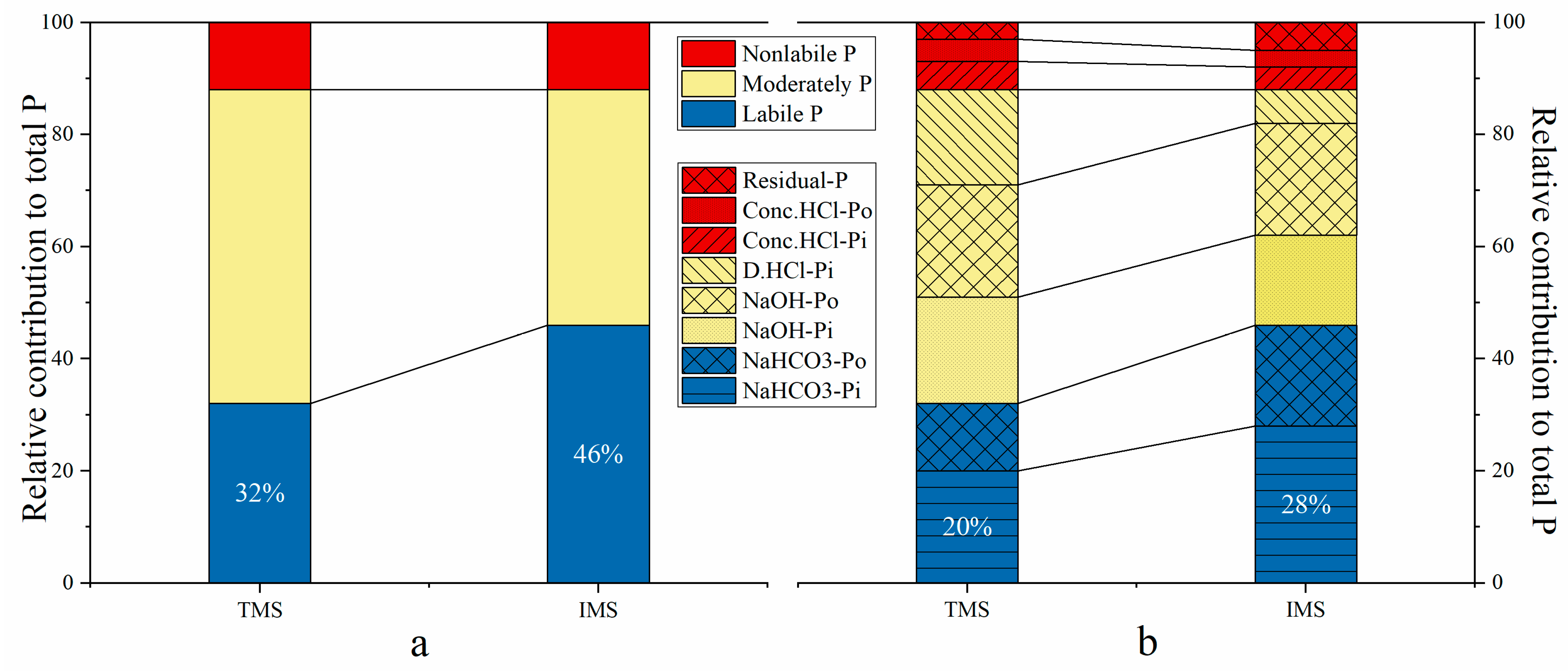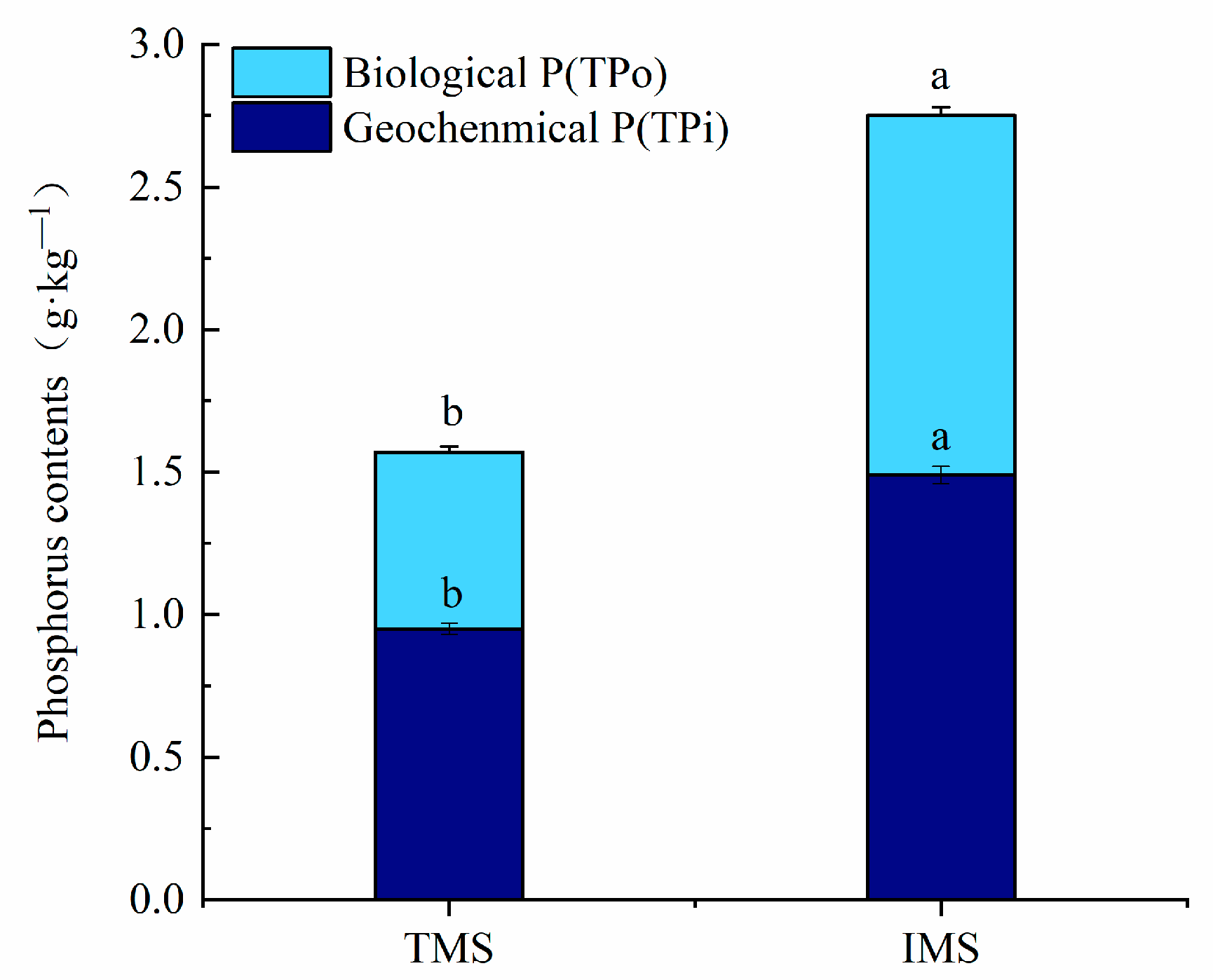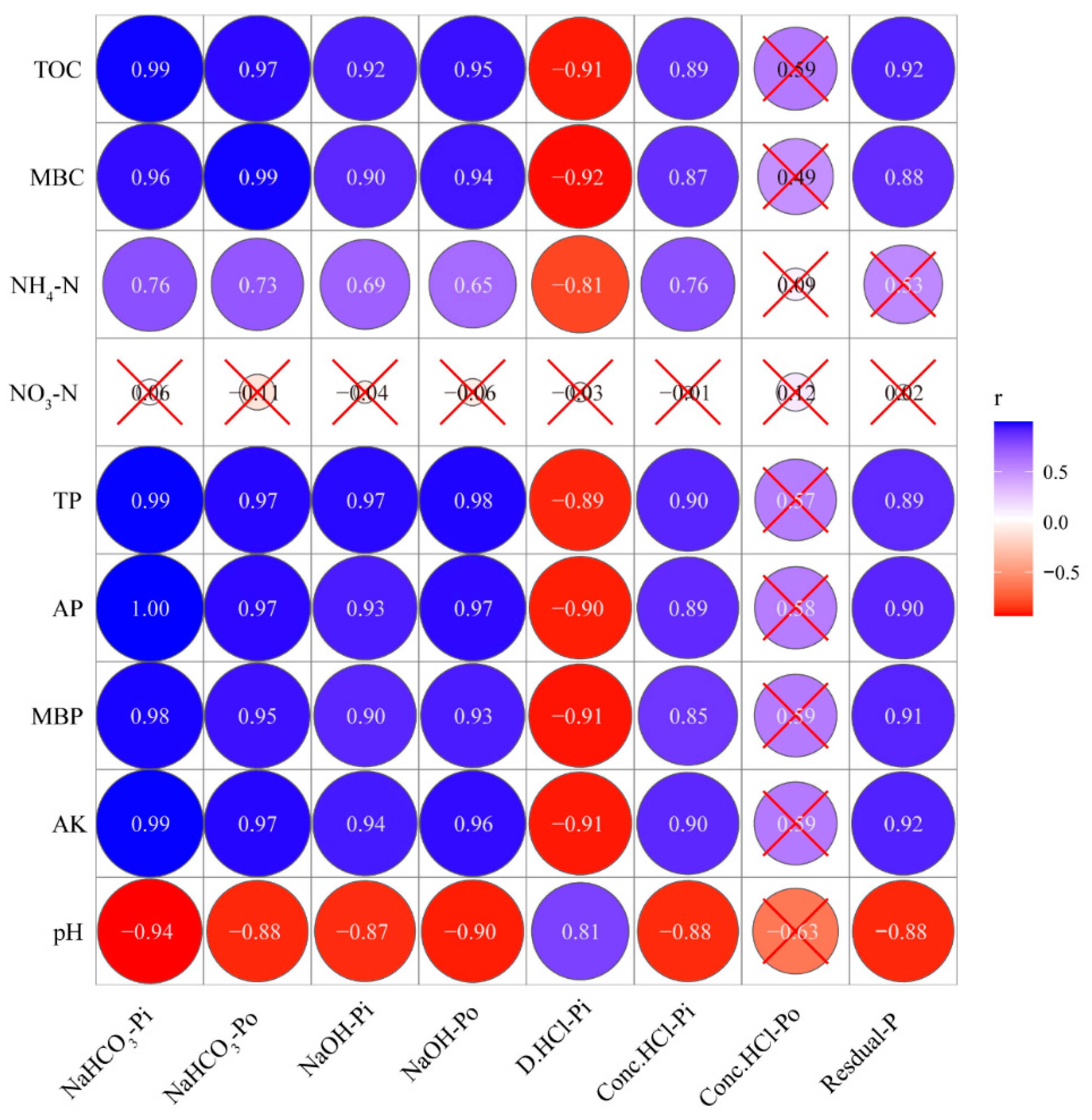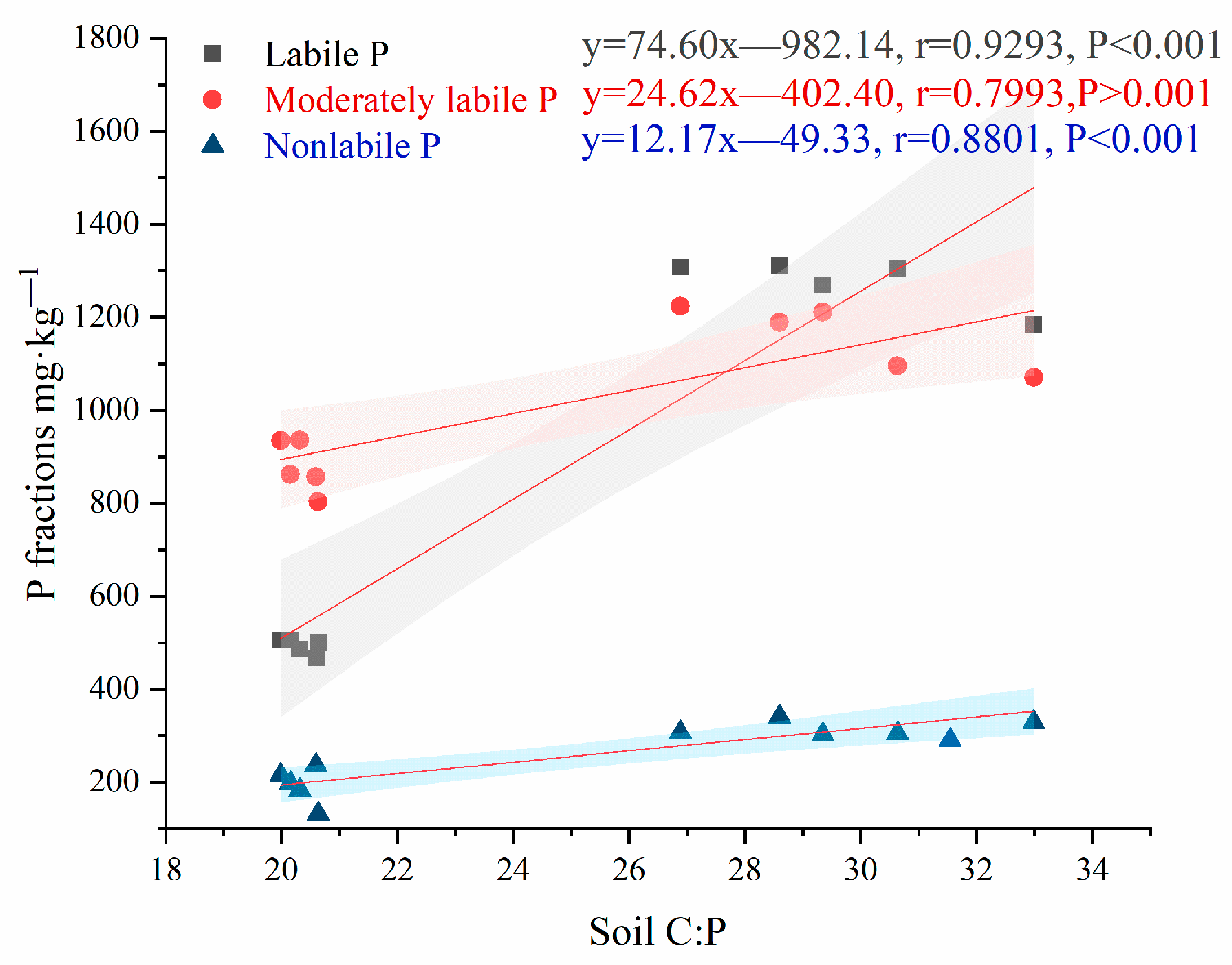Effects of Long-Term Chemical and Organic Fertilizer Application on Soil Phosphorus Fractions in Lei Bamboo Plantations
Abstract
:1. Introduction
2. Materials and Methods
2.1. Study Area Description and Soil Collection
2.2. Soil Basic Properties
2.3. Fractionation Procedure for Soil P
2.4. Statistical Analysis
3. Results
3.1. Soil Basic Properties
3.2. Soil P Fractions
3.3. Correlation Analysis between P Fractions and Soil Properties
4. Discussion
4.1. Impacts of Long-Term Application of Organic Amendments on Soil Physicochemical Properties
4.2. Impacts of Long-Term Application of Organic Amendments on the P Fractions and MBP
4.3. Impacts of Long-Term Application of Organic Amendments on Soil Stoichiometry and Its Ecological Implication
5. Conclusions
Author Contributions
Funding
Institutional Review Board Statement
Informed Consent Statement
Data Availability Statement
Acknowledgments
Conflicts of Interest
References
- Zhang, M.X.; Chen, S.L.; Jiang, H.; Peng, C.H.; Zhang, J.M.; Zhou, G.M. The impact of intensive management on net ecosystem productivity and net primary productivity of a Lei bamboo forest. Ecol. Model. 2020, 435, 109248. [Google Scholar] [CrossRef]
- Huang, Z.T.; Li, Y.F.; Jiang, P.K.; Chang, S.X.; Zhou, G.M. Long-term intensive management increased carbon occluded in phytolith (PhytOC) in bamboo forest soils. Sci. Rep. 2014, 4, 3602. [Google Scholar] [CrossRef] [PubMed] [Green Version]
- Jiang, P.K.; Xu, Q.F.; Xu, Z.H.; Cao, Z.H. Seasonal changes in soil labile organic carbon pools within a Phyllostachys praecox stand under high rate fertilization and winter mulch in subtropical China. For. Ecol. Manag. 2006, 236, 30–36. [Google Scholar] [CrossRef]
- Li, Y.F.; Jiang, P.K.; Chang, S.X.; Wu, J.S.; Lin, L. Organic mulch and fertilization affect soil carbon pools and forms under intensively managed bamboo (Phyllostachys praecox) forests in southeast China. J. Soils Sediments 2010, 10, 739–747. [Google Scholar] [CrossRef]
- Kunito, T.; Hiruta, N.; Miyagishi, Y.; Sumi, H.; Moro, H. Changes in phosphorus fractions caused by increased microbial activity in forest soil in a short-term incubation study. Chem. Speciat. Bioavailab. 2018, 30, 9–13. [Google Scholar] [CrossRef] [Green Version]
- Chen, X.H.; Yan, X.J.; Wang, M.K.; Cai, Y.Y.; Weng, X.F.; Su, D.; Guo, J.X.; Wang, W.Q.; Hou, Y.; Ye, D.L.; et al. Long-term excessive phosphorus fertilization alters soil phosphorus fractions in the acidic soil of pomelo orchards. Soil Tillage Res. 2022, 215, 105214. [Google Scholar] [CrossRef]
- Wang, Q.; Qin, Z.H.; Zhang, W.W.; Chen, Y.H.; Zhu, P.; Peng, C.; Wang, L.; Zhang, S.X.; Colinet, G. Effect of long-term fertilization on phosphorus fractions in different soil layers and their quantitative relationships with soil properties. J. Integr. Agric. 2022, 21, 2720–2733. [Google Scholar] [CrossRef]
- Rahman, M.M.; Kamal, M.Z.U.; Ranamukhaarachchi, S.; Alam, M.S.; Alam, M.K.; Khan, M.A.R.; Ahmed, F. Effects of organic amendments on soil aggregate stability, carbon sequestration, and energy use efficiency in wetland paddy cultivation. Sustainability 2022, 14, 4475. [Google Scholar] [CrossRef]
- Zheng, R.H. Allelopathy of Cover Planting on Decline of Phyllostachys praecox Stand; Chinese Academy of Forestry: Beijing, China, 2006. [Google Scholar]
- Zhang, X.P.; Huang, Z.Y.; Zhong, Z.K.; Li, Q.L.; Bian, F.Y.; Gao, G.B.; Yang, C.B.; Wen, X. Evaluating the rhizosphere and endophytic microbiomes of a bamboo plant in response to the long-term application of heavy organic amendment. Plants 2022, 11, 2129. [Google Scholar] [CrossRef]
- Allison, V.J.; Condron, L.M.; Peltzer, D.A.; Richardson, S.J.; Turner, B.L. Changes in enzyme activities and soil microbial community composition along carbon and nutrient gradients at the Franz Josef chronosequence, New Zealand. Soil Biol. Biochem. 2007, 39, 1770–1781. [Google Scholar] [CrossRef]
- Kirkby, C.A.; Kirkegaard, J.A.; Richardson, A.E.; Wade, L.J.; Blanchard, C.; Batten, G. Stable soil organic matter: A comparison of C:N:P:S ratios in Australian and other world soils. Geoderma 2011, 163, 197–208. [Google Scholar] [CrossRef]
- Wang, J.P.; Wu, Y.H.; Zhou, J.; Bing, H.J.; Sun, H.Y. Carbon demand drives microbial mineralization of organic phosphorus during the early stage of soil development. Biol. Fertil. Soils 2016, 52, 825–839. [Google Scholar] [CrossRef]
- Zhou, K.J.; Lu, X.K.; Mori, T.; Mao, Q.G.; Wang, C.M.; Zheng, H.; Mo, H.; Hou, E.Q.; Mo, J.M. Effects of long-term nitrogen deposition on phosphorus leaching dynamics in a mature tropical forest. Biogeochemistry 2018, 138, 215–224. [Google Scholar] [CrossRef]
- Almeida, J.A.d.; Corrêa, J.; Schmitt, C. Clay Mineralogy of Basaltic Hillsides Soils in the Western State of Santa Catarina. Rev. Bras. De Ciência Do Solo 2018, 42, e0170086. [Google Scholar] [CrossRef] [Green Version]
- Burman, U.; Garg, B.K.; Kathju, S. Effect of Phosphorus Application on Clusterbean under Different Intensities of Water Stress. J. Plant Nutr. 2009, 32, 668–680. [Google Scholar] [CrossRef]
- Lin, W.Y.; Huang, T.K.; Leong, S.J.; Chiou, T.J. Long-distance call from phosphate: Systemic regulation of phosphate starvation responses. J. Exp. Bot. 2014, 65, 1817–1827. [Google Scholar] [CrossRef]
- Meena, M.D.; Narjary, B.; Sheoran, S.H.; Joshi, P.K.; Chinchmalatpure, A.R.; Yadav, G.; Yadav, R.K.; Meena, M.K. Changes of phosphorus fractions in saline soil amended with municipal solid waste compost and mineral fertilizers in a mustard-pearl millet cropping system. Catena 2018, 160, 32–40. [Google Scholar] [CrossRef]
- Chen, Y.Q.; Chen, G.T.; Liang, Z.; Li, R.H.; Ma, H.Y.; Tu, L.H. Ten-year nitrogen addition did not significantly affect soil phosphorus fractions in a Pleioblastus amarus plantation. Ecol. Environ. Sci. 2018, 27, 677–684. [Google Scholar]
- Vance, C.P. Phosphorus as a Critical Macronutrient. In The Molecular and Physiological Basis of Nutrient Use Efficiency in Crops; John Wiley & Sons: London, UK, 2011; pp. 229–265. [Google Scholar]
- Annaheim, K.E.; Rufener, C.B.; Frossard, E.; Bünemann, E.K. Hydrolysis of organic phosphorus in soil water suspensions after addition of phosphatase enzymes. Biol. Fertil. Soils 2013, 49, 1203–1213. [Google Scholar] [CrossRef] [Green Version]
- Prakash, D.; Benbi, D.K.; Saroa, G.S. Land-use effects on phosphorus fractions in Indo-Gangetic alluvial soils. Agrofor. Syst. 2018, 92, 437–448. [Google Scholar] [CrossRef]
- Helfenstein, J.; Pistocchi, C.; Oberson, A.; Tamburini, F.; Frossard, E. Estimates of mean residence times of phosphorus in commonly-considered inorganic soil phosphorus pools. Biogeosciences 2020, 17, 441–454. [Google Scholar] [CrossRef]
- Li, F.Y.; Yuan, C.Y.; Yuan, Z.Q.; You, Y.J.; Hu, X.F.; Wang, S.; Li, G.Y. Bioavailable phosphorus distribution in alpine meadow soil is affected by topography in the Tian Shan Mountains. J. Mt. Sci. 2020, 17, 158–173. [Google Scholar] [CrossRef]
- Zhang, H.Z.; Shi, L.L.; Lu, H.B.; Shao, Y.H.; Liu, S.R.; Fu, S.L. Drought promotes soil phosphorus transformation and reduces phosphorus bioavailability in a temperate forest. Sci. Total Environ. 2020, 732, 139295. [Google Scholar] [CrossRef] [PubMed]
- Chavarro-Bermeo, J.P.; Arruda, B.; Mora-Motta, D.A.; Bejarano-Herrera, W.; Ortiz-Morea, F.A.; Somenahally, A.; Silva-Olaya, A.M. Responses of soil phosphorus fractions to land-ues change in colombian Amazon. Sustainability 2022, 14, 2285. [Google Scholar] [CrossRef]
- Ding, Z.L.; Kheir, A.M.S.; Ali, M.G.M.; Ali, O.A.M.; Abdelaal, A.I.N.; Lin, X.E.; Zhou, Z.H.; Wang, B.Z.; Liu, B.B.; He, Z.L. The integrated effect of salinity, organic amendments, phosphorus fertilizers, and deficit irrigation on soil properties, phosphorus fractionation and wheat productivity. Sci. Rep. 2020, 10, 2736. [Google Scholar] [CrossRef] [Green Version]
- Verma, S.; Subehia, S.K.; Sharma, S.P. Phosphorus fractions in an acid soil continuously fertilized with mineral and organic fertilizers. Biol. Fertil. Soils 2005, 41, 295–300. [Google Scholar] [CrossRef]
- Zhang, J.Q. Effects of Long Term Fertilizalion on the Form and Distbution of Organic Nitrogen and Phosphorus in Several Typical Soils in China; Chinese Academy of Agricultural Sciences: Beijing, China, 2003. [Google Scholar]
- Brookes, P.C.; Landman, A.; Pruden, G.; Jenkinson, D.S. Chloroform fumigation and the release of soil nitrogen: A rapid direct extraction method to measure microbial biomass nitrogen in soil. Soil Biol. Biochem. 1985, 17, 837–842. [Google Scholar] [CrossRef]
- Tiessen, H.; Moir, J.O. Characterization of available P by sequential extraction. In Soil Sampling and Methods of Analysis; Lewis Publishers: Ann Arbor, MI, USA, 1993; pp. 75–86. [Google Scholar]
- Hedley, M.J.; Stewart, J.W.B.; Chauhan, B.S.C. Changes in inorganic and organic soil phosphorus fractions induced by cultivation practices and by laboratory incubations. Soil Sci. Soc. Am. J. 1982, 46, 970–976. [Google Scholar] [CrossRef]
- Vance, E.D.; Brookes, P.C.; Jenkinson, D.S. An extraction method for measuring soil microbial biomass C. Soil Biol. Biochem. 1987, 19, 703–707. [Google Scholar] [CrossRef]
- Hu, B.; Yang, B.; Pang, X.Y.; Bao, W.K.; Tian, G.L. Responses of soil phosphorus fractions to gap size in a reforested spruce forest. Geoderma 2016, 279, 61–69. [Google Scholar] [CrossRef]
- Gai, X.; Li, S.C.; Zhang, X.P.; Bian, F.Y.; Yang, C.B.; Zhong, Z.K. Changes in soil phosphorus availability and associated microbial properties after chicken farming in Lei bamboo (Phyllostachys praecox) forest ecosystems. Land Degrad. Dev. 2021, 32, 3008–3022. [Google Scholar] [CrossRef]
- Xavier, F.A.D.S.; Almeida, E.F.; Cardoso, I.M.; Agroecosystems, E.d.S. Soil phosphorus distribution in sequentially extracted fractions in tropical coffee-agroecosystems in the Atlantic Forest biome, Southeastern Brazil. Nutr. Cycl. Agroecosyst. 2011, 89, 31–44. [Google Scholar] [CrossRef]
- Khan, A.; Jin, X.; Yang, X.Y.; Guo, S.L.; Zhang, S.L. Phosphorus Fractions Affected by Land Use Changes in Soil Profile on the Loess Soil. J. Soil Sci. Plant Nutr. 2021, 21, 722–732. [Google Scholar] [CrossRef]
- Reeve, J.R.; Endelman, J.B.; Miller, B.E.; Hole, D.J. Residual effects of compost on soil quality and dryland wheat yield sixteen years after compost application. Soil Sci. Soc. Am. J. 2012, 76, 278–285. [Google Scholar] [CrossRef]
- Thangarajan, R.; Bolan, N.S.; Tian, G.L.; Naidu, R.; Kunhikrishnan, A. Role of organic amendment application on greenhouse gas emission from soil. Sci. Total Environ. 2013, 465, 72–96. [Google Scholar] [CrossRef] [PubMed]
- Tejada, M.; Garcia, C.; Gonzalez, J.L.; Hernandez, M.T. Use of organic amendment as a strategy for saline soil remediation: Influence on the physical, chemical and biological properties of soil. Soil Biol. Biochem. 2006, 38, 1413–1421. [Google Scholar] [CrossRef]
- Srivastava, P.; Singh, P.K.; Singh, R.; Bhadouria, R.; Singh, D.K.; Singh, S.; Afreen, T.; Tripathi, S.; Singh, P.; Singh, H.; et al. Relative availability of inorganic N-pools shifts under land use change: An unexplored variable in soil carbon dynamics. Ecol. Indic. 2016, 64, 228–236. [Google Scholar] [CrossRef]
- Gabriela, V.; Phuong-Thi, N.; Cornelia, R.; Marcela, C.F.; Yonathan, R.; Benjamin, L.T.; Maria, D.L.L.M. Chemical nature of residual phosphorus in Andisols. Geoderma 2016, 271, 27–31. [Google Scholar]
- Srivastava, P.; Singh, R.; Bhadouria, R.; Tripathi, S.; Singh, P.; Singh, H.; Raghubanshi, A.S. Organic amendment impact on SOC dynamics in dry tropics: A possible role of relative availability of inorganic-N pools. Agric. Ecosyst. Environ. 2016, 235, 38–50. [Google Scholar] [CrossRef]
- Tang, C.; Rengel, Z. Role of Plant Cation/Anion Uptake Ratio in Soil Acidification. In Handbook of Soil Acidity; Rengel, Z., Ed.; Marcel Dekker: New York, NY, USA, 2003; pp. 57–81. [Google Scholar]
- Zhai, W.; Zhong, Z.; Gao, G.; Yang, H. Influence of mulching management on soil bacterial structure and diversity in Phyllostachys praecox stands. Scientia. Silvae Sin 2017, 53, 133–142. [Google Scholar]
- Bowman, R.A.; Cole, C.V. An exploratory method for fraction of organic phosphorus from grassland soils. Soil Sci. 1978, 125, 95–101. [Google Scholar] [CrossRef]
- Ahmed, W.; Huang, J.; Liu, K.L.; Qaswar, M.; Khan, M.N.; Chen, J.; Sun, G.; Huang, Q.H.; Liu, Y.R.; Liu, G.R.; et al. Changes in phosphorus fractions associated with soil chemical properties under long-term organic and inorganic fertilization in paddy soils of southern China. PLoS ONE 2019, 14, e0216881. [Google Scholar] [CrossRef] [PubMed]
- Schrijver, A.D.; Vesterdal, L.; Hansen, K.; Frenne, P.D.; Augosto, L.; Achat, D.L.; Staelens, J.; Baeten, L.; Keersmaeker, L.D.; Neve, S.D.; et al. Four decades of post-agricultural forest development have caused major redistributions of soil phosphorus fractions. Oecologia. 2012, 169, 221–234. [Google Scholar] [CrossRef] [PubMed]
- Yang, C.B.; Ni, H.J.; Zhong, Z.K.; Zhang, X.P.; Bian, F.Y. Changes in soil carbon pools and components induced by replacing secondary evergreen broadleaf forest with Moso bamboo plantations in subtropical China. Catena 2019, 180, 309–319. [Google Scholar] [CrossRef]
- Achat, D.L.; Augusto, L.; Bakker, M.R.; Budynek, A.; Morel, C. Microbial processes controlling p availability in forest spodosols as affected by soil depth and soil properties. Soil Biol. Biochem. 2012, 44, 39–48. [Google Scholar] [CrossRef]
- Yan, Z.J.; Chen, S.; Dari, B.; Sihi, D.; Chen, Q. Phosphorus transformation response to soil properties changes induced by manure application in a calcareous soil. Geoderma 2018, 322, 163–171. [Google Scholar] [CrossRef]
- Qu, F.Z.; Meng, L.; Xia, J.B.; Huang, H.S.; Zhan, C.; Li, Y.Z. Soil phosphorus fractions and distributions in estuarine wetlands with different climax vegetation covers in the Yellow River Delta. Ecol. Indic. 2021, 125, 1–8. [Google Scholar] [CrossRef]
- McGroddy, M.E.; Silver, W.L.; Oliveira, R.C.; Mello, W.Z.; Keller, M. Retention of phosphorus in highly weathered soils under a lowland Amazonian forest ecosystem. J. Geophys. Res. 2008, 113, G04012. [Google Scholar] [CrossRef]
- Cao, N.; Zhi, M.L.; Zhao, W.Q.; Pang, J.Y.; Hu, W.; Zhou, Z.G.; Meng, Y.L. Straw retention combined with phosphorus fertilizer promotes soil phosphorus availability by enhancing soil P-related enzymes and the abundance of phoC and phoD genes. Soil Tillage Res. 2022, 220, 105390. [Google Scholar] [CrossRef]
- Soltangheisi, A.; Rodrigues, M.; Coelho, M.J.A.; Gasperini, A.M.; Sartor, L.R.; Pavinato, P.S. Changes in soil phosphorus lability promoted by phosphate sources and cover crops. Soil Tillage Res. 2018, 179, 20–28. [Google Scholar] [CrossRef]
- Kunhikrishnan, A.; Thangarajan, R.; Bolan, N.S.; Xu, Y.; Naidu, R.J. Functional relationships of soil acidification, liming, and greenhouse gas flux. Adv. Agron. 2016, 139, 61–71. [Google Scholar]
- Cross, A.F.; Schlesinger, W.H. A literature review and evaluation of the. Hedley fractionation: Applications to the biogeochemical cycle of soil phosphorus in natural ecosystems. Geoderma 1995, 64, 197–214. [Google Scholar] [CrossRef]
- Zeng, Q.X.; Zeng, X.M.; Lin, K.M.; Zhang, Q.F.; Cheng, L.; Zhou, J.C.; Lin, Q.Y.; Chen, Y.M.; Xu, J.G. Responses of soil phosphorus fractions and microorganisms to nitrogen application in a sub-tropical Phyllostachys pubescen forest. Chin. J. Appl. Ecol. 2020, 31, 753–760. [Google Scholar]
- Wang, J.C.; Ren, C.Q.; Cheng, H.T.; Zou, Y.K.; Bughio, M.A.; Li, Q.F. Conversion of rainforest into agroforestry and monoculture plantation in China: Consequences for soil phosphorus forms and microbial community. Sci. Total Environ. 2017, 595, 769–778. [Google Scholar] [CrossRef] [PubMed]
- Zhang, S.; Wang, L.; Chen, S.; Fan, B.; Huang, S.; Chen, Q. Enhanced phosphorus mobility in a calcareous soil with organic amendments additions: Insights from a long term study with equal phosphorus input. J. Environ. Manag. 2022, 306, 114451. [Google Scholar] [CrossRef]
- Liu, J.; Han, C.Q.; Zhao, Y.H.; Yang, J.J.; Menun, B.J.C.; Hu, Y.F.; Li, J.M.; Liu, H.; Sui, P.; Chen, Y.Q.; et al. The chemical nature of soil phosphorus in response to long-term fertilization practices: Implications for sustainable phosphorus management. J. Clean. Prod. 2020, 272, 123093. [Google Scholar] [CrossRef]
- Qin, X.C.; Guo, S.F.; Zhai, L.M.; Pan, J.T.; Khoshnevisan, B.; Wu, S.X.; Wang, H.Y.; Yang, B.; Ji, J.H.; Liu, H.B. How long-term excessive manure application affects soil phosphorous species and risk of phosphorous loss in fluvo-aquic soil. Environ. Pollut. 2020, 266, 115304. [Google Scholar] [CrossRef]
- Chen, S.; Zhang, S.; Yan, Z.J.; Peng, Y.T.; Chen, Q. Differences in main processes to transform phosphorus influenced by ammonium nitrogen in flooded intensive agricultural and steppe soils. Chemosphere 2019, 226, 192–200. [Google Scholar] [CrossRef]
- Christine, H.; Alfons, W.; Marie, S. Soil microbial biomass C:N:P stoichiometry and microbial use of organic phosphorus. Soil Biol. Biochem. 2015, 85, 119–129. [Google Scholar]
- Hou, E.Q.; Chen, C.G.; Wen, D.Z.; Liu, X. Relationships of phosphorus fractions to organic carbon content in surface soils in mature subtropical forests, Dinghushan, China. Soil Res. 2014, 52, 55–63. [Google Scholar] [CrossRef] [Green Version]
- Jangid, K.; Williams, M.A.; Franzluebbers, A.J.; Sanderlin, J.S.; Reeves, J.H.; Jenkins, M.B.; Endale, D.M.; Coleman, D.C.; Whitman, W.B. Relative impacts of land-use management intensity and fertilization upon soil microbial community structure in agricultural systems. Soil Biol. Biochem. 2008, 40, 2843–2853. [Google Scholar] [CrossRef]
- Wang, Q.; Zhan, X.Y.; Zhang, S.X.; Peng, C.; Gao, H.J.; Zhang, X.Z.; Zhu, P.; Colinet, G. Phosphorus adsorption and desorption characteristics and its response to soil properties of black soil under long-term different fertilization. Sci. Agric. Sinica. 2019, 52, 3866–3877. [Google Scholar]
- Rodrigo, F.J.; Vasconcellos, I.A.; Tales, T.; Vidal, B. Iron oxides and organic matter on soil phosphorus availability. Cienc. Agrotecnologia 2016, 40, 369–379. [Google Scholar]
- Fan, H.B.; Wu, J.P.; Liu, W.F.; Yuan, Y.H.; Hu, L.; Cai, Q.K. Linkages of plant and soil C:N:P stoichiometry and their relationships to forest growth in subtropical plantations. Plant Soil 2015, 392, 127–138. [Google Scholar] [CrossRef]
- Zhang, Y.J.; Gao, W.; Luan, H.A.; Tang, J.W.; Li, R.N.; Li, M.Y.; Zhang, H.Z.; Huang, S.W. Effects of a decade of organic fertilizer substitution on vegetable yield and soil phosphorus pools, phosphatase activities, and the microbial community in a greenhouse vegetable production system. J. Integr. Agric. 2022, 21, 2119–2133. [Google Scholar] [CrossRef]
- Tian, J.H.; Tang, M.T.; Xu, X.; Luo, S.S.; Condron, L.M.; Lambers, H.; Cai, K.Z.; Wang, J.W. Soybean (Glycine max (L.) Merrill) intercropping with reduced nitrogen input influences rhizosphere phosphorus dynamics and phosphorus acquisition of sugarcane (Saccharum officinarum). Biol. Fertil. Soils 2020, 56, 1065–1073. [Google Scholar] [CrossRef]
- Muhammad, Q.; Waqas, A.; Huang, J.; Fan, H.Z.; Shi, X.J.; Jiang, X.J.; Liu, K.L.; Xu, Y.M.; He, Z.Q.; Waleed, A.; et al. Soil carbon (C), nitrogen (N) and phosphorus (P) stoichiometry drives phosphorus lability in paddy soil under long-term fertilization: A fractionation and path analysis study. PLoS ONE 2019, 14, e0218195. [Google Scholar]





| TMS | IMS | |
|---|---|---|
| pH | 4.48 ± 0.03 a | 3.90 ± 0.05 b |
| TOC (g·kg−1) | 34.38 ± 0.20 b | 83.07 ± 0.99 a |
| MBC (mg·kg−1) | 356.67 ± 13.55 b | 793.78 ± 16.36 a |
| NH4-N (mg·kg−1) | 21.37 ± 2.64 b | 30.57 ± 0.75 a |
| NO3-N (mg·kg−1) | 10.74 ± 0.17 a | 10.81 ± 0.32 a |
| TP (g·kg−1) | 1.69 ± 0.00 b | 2.81 ± 0.06 a |
| AP (mg·kg−1) | 304.50 ± 5.42 b | 789.06 ± 8.24 a |
| MBP (mg·kg−1) | 43.26 ± 2.26 b | 115.22 ± 5.48 a |
| AK (mg·kg−1) | 68.24 ± 0.55 b | 280.94 ± 1.48 a |
| Microbial C:P | 8.35 ± 0.61 a | 6.95 ± 0.33 a |
| Soil C:P | 46.18 ± 1.85 b | 63.31 ± 6.13 a |
| PAC | 0.18 ± 0.00 b | 0.28 ± 0.01 a |
| P Fraction | TMS | IMS |
|---|---|---|
| NaHCO3-Pi | 0.31 ± 0.04 b | 0.77 ± 0.02 a |
| NaHCO3-Po | 0.18 ± 0.06 b | 0.50 ± 0.03 a |
| ΣLabile P | 0.49 ± 0.01 b | 1.28 ± 0.04 a |
| NaOH-Pi | 0.30 ± 0.00 b | 0.44 ± 0.02 a |
| NaOH-Po | 0.32 ± 0.02 b | 0.55 ± 0.02 a |
| D.HCl-Pi | 0.26 ± 0.01 a | 0.17 ± 0.08 b |
| ΣModerately P | 0.88 ± 0.43 b | 1.16 ± 0.04 a |
| Conc.HCl-Pi | 0.08 ± 0.00 b | 0.11 ± 0.00 a |
| Conc.HCl-Po | 0.06 ± 0.01 a | 0.08 ± 0.00 a |
| ΣSparingly labile P | 0.14 ± 0.02 a | 0.19 ± 0.01 a |
| Residual P | 0.06 ± 0.01 b | 0.13 ± 0.01 a |
| ΣNonlabile P | 0.20 ± 0.02 b | 0.32 ± 0.04 a |
Publisher’s Note: MDPI stays neutral with regard to jurisdictional claims in published maps and institutional affiliations. |
© 2022 by the authors. Licensee MDPI, Basel, Switzerland. This article is an open access article distributed under the terms and conditions of the Creative Commons Attribution (CC BY) license (https://creativecommons.org/licenses/by/4.0/).
Share and Cite
Li, Q.; Li, A.; Huang, Z.; Zhong, Z.; Bian, F.; Zhang, X. Effects of Long-Term Chemical and Organic Fertilizer Application on Soil Phosphorus Fractions in Lei Bamboo Plantations. Sustainability 2022, 14, 15658. https://doi.org/10.3390/su142315658
Li Q, Li A, Huang Z, Zhong Z, Bian F, Zhang X. Effects of Long-Term Chemical and Organic Fertilizer Application on Soil Phosphorus Fractions in Lei Bamboo Plantations. Sustainability. 2022; 14(23):15658. https://doi.org/10.3390/su142315658
Chicago/Turabian StyleLi, Qiaoling, Aibo Li, Zhiyuan Huang, Zheke Zhong, Fangyuan Bian, and Xiaoping Zhang. 2022. "Effects of Long-Term Chemical and Organic Fertilizer Application on Soil Phosphorus Fractions in Lei Bamboo Plantations" Sustainability 14, no. 23: 15658. https://doi.org/10.3390/su142315658





